|
Bottle Gourd. Á multi purpose utensil 10.000 old!
The Bottle Gourd is one of the oldest know cultivated plant and has been used by man for both functional and decorative objects all over the world throughout history and is believed to have spanned the entire globe in prehistoric times. It was known mostly by cultures in temperate and tropical zones because this is where gourd grow best. Today Bottle Gourd is still considered one of nature's greatest gifts to mankind.
 |
| Bottle Gourd (Lagenaria
siceraria) |
The Bottle Gourd (Lagenaria siceraria) is a domesticated member of the Cucurbitaceae (cucumber, melon, and squash family) with an ancient pantropical distribution.
The Bottle Gourd is a diploid, self-compatible monoecious annual (monoecious plants do not have separate male and female individuals). The bottle gourd is a diploid, monoecious plant of the Cucurbitacea. The plant has thick vines with large white flowers that open only at night. The fruit comes in a large variety of shapes, selected for by their human users.
The Bottle Gourd was one of the first cultivated plants in the world (second after Rye - Secale cereale 11,050 BC), grown not primarily for food, but for use as a water container. The bottle gourd may have been carried from Africa to Asia, Europe and the Americas in the course of human migration, or by seeds floating across the oceans inside the gourd. It has been proven to be in New World prior to the arrival of Columbus. It shares its common name (C calabash) with that of the calabash tree (Crescentia cujete).
Domestication History
The bottle gourd is native to Africa: wild populations of the plant have recently been discovered in Zimbabwe. Two subspecies, likely representing two separate domestication events, have been identified: Lagenaria siceraria spp. siceraria (in Africa, domesticated some 4,000 years ago) and L. s. spp. asiatica (Asia, domesticated at least 10,000 years ago, probably more like 12,000 years ago). The rind of the domesticated calabash, unlike that of its wild counterpart, is thick and waterproof.
Domesticated bottle gourds have been identified in the Americas at sites such as Guila Naquitz in Mexico by ~10,000 years ago. Comparisons of DNA sequences from archaeological bottle gourd specimens and modern Asian and African landraces identify Asia as the source of its introduction to the New World.
In Europe, bottle gourd only appears with some frequency from the Roman period onwards. Genetically, the ancient samples found in Europe and one commercial cultivar L. siceraria cv. ‘Herkuleskeule’ are of Asian origin as identified by
DNA.
 |
| Gourds are used for making
rafts |
So important were these gourds in the daily lives of native people, that they were introduced into human cultures throughout the world. Probably their most important use was for containers, including pots, pans and bowls, and these gourds are still used to this day in many parts of the world. For water vessels, they are still preferred over earthenware jars because they are lighter and they cool the water by evaporation. In addition to containers and eating utensils, Lagenaria gourds are used for fishing floats, rafts, pipes and snuffboxes.
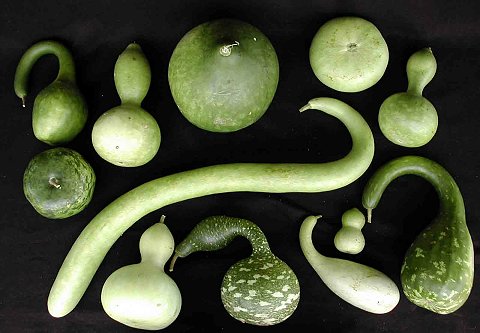 |
| Various shapes of Bottle Gourd |
Mature Lagenaria gourds come in an astonishing array of shapes and sizes, from tiny gourds only a few inches (5 cm) long to giants over seven feet (2 m) in length. Some of the distinctive varietal forms include "dumbbell", "club", "dipper", "powder-horn", "calabash pipe", "kettle", "dolphin", "trough", "birdhouse", and "snake" gourds. With rich soil, ample sunlight and water, they grow readily in warm temperate and tropical regions throughout the
world.
Africa
Hollowed out and dried calabashes are a very typical utensil in households across West Africa. They are used to clean rice, carry water, and as food containers. Smaller sizes are used as bowls to drink palm wine.
The dried calabashes can be decorated. The natural colour of the outer skin of dried calabash is warm yellow, and it darkens with age and use. The calabashes may be stained in other colours: rose, by rubbing them with millet leaves; blue, with indigo among others. They can also be darkened by hanging them in a smoky
room.
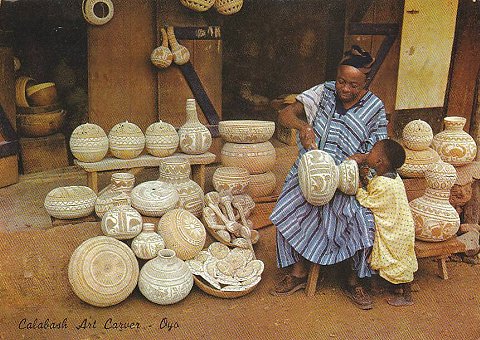 |
| Traditional calabash
carving in Oyo territory, Nigeria |
However, calabashes can be decorated by several different techniques or methods according to the tradition of the area; though some people can use them as they are. They simply wash the calabash regularly. They are numerous varieties of designs and patterns which calabash carvers carry out for calabash decoration. These are achieved by applying the following main techniques or methods namely: Scraping; Carving; Scorching; Pyro-engraving and Pressure-engraving. In the most areas, the techniques or methods in use are combined.
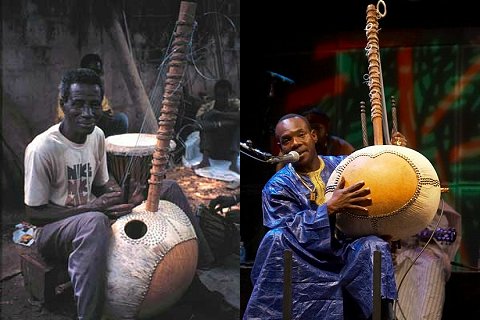 |
| Kora Maker from Gabia (left)
and Kora player from Mali (right) |
 |
| Bara drums from calabash (left)
and Bara players from Mali (right) |
Calabashes are used in making the West African kora (a harp-lute), xalam/ngoni (a lute) and the goje (a traditional fiddle). They also serve as resonators underneath the balafon (West African marimba). The calabash is also used in making the shegureh (a Sierra Leonean women's rattle)[17] and balangi (a Sierra Leonean type of balafon) musical instruments. Sometimes, large calabashes are simply hollowed, dried and used as percussion instruments, especially by Fulani, Songhai, Gur-speaking and Hausa
peoples.
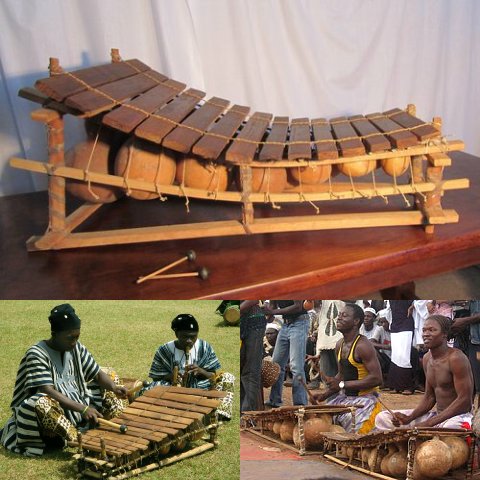 |
Balafons with gourds.
Traditional musical instument of West Africa (up)
Balafon players from Ghana (left), from Burkina Fasoi
(right) |
Shaker gourds "Shekere" are probably one of the earliest of all musical instruments. In Africa, it comes in many shapes and sizes, is played in a variety of styles, and has many different names. In Africa it is found primarily, but not exclusively, in the countries of Nigeria, Togo, Ghana, Benin, Sierra Leone and Côte d'Ivoire (there are many parts of Africa where you will not hear this instrument).
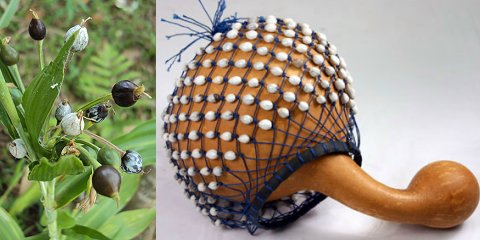 |
| Job's tears (Coix Lacryma-jobi)
áñéóôåñÜ). "Shekere"
(right) |
The hollow gourds are covered with a loose netting strung with hundreds of beads from Job's tears (Coix lacryma-jobi). The tear-shaped "bead" is actually a hollow involucre that contained the female flowers of this pantropical grass. As the beads slap against the gourd, a loud shaker sound is produced--as good as any modern instrument for this purpose. Using the neck of the gourd as a handle, the sound is amplified by the hollow
interior.
 |
| Women of Tourou village
wearing painted gourd hats |
The calabash is also used as a headgear by the women of Tourou, small village lost on the border of Nigeria in the extreme North of Cameroon. A red-orangy gourd, more or less
decorated.
 |
| Erbore tribe children wear hats made from the calabash |
In East Africa, especialy in Ethiopia - Omo valley gourds are used widely. Erbore tribe children wear hats made from the calabash to protect them from the sun. Karo tribe woman for winnowing grain by pouring it from one gourd to another. Dassanech women fro carrying water and
food.
 |
Women with calalbash
utensils. Tribes from Omo valley Ethiopia.
Karo (up left), Mursi (up right), Dassanech
(down left), Hamar (down right) |
Calabash bowls and gourds are used as indispensable utensils in everyday Hamar household life - for drinking and carrying water, coffee, milk or sour buttermilk. The wide, hollowed out and dried calabash bowls are also used for shaking butter, containing food or preparing the traditional mixture of butterfat and red clay that is routinely rubbed into the long, tightly twisted strands of hair preferred by married Hamar women.
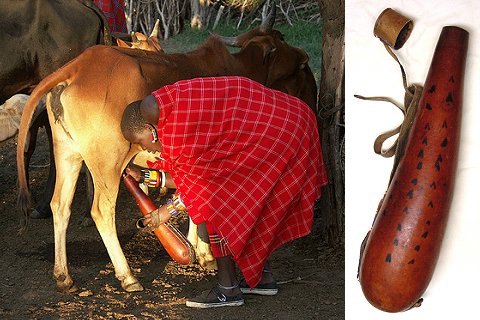 |
| Masai woman milking her cowÝ using gourd
vessel (left), " Kibuyu"
(right) |
A special kind of gourd (called “kibuyu” in Swahili) was used by the Maasai to hold a blend of milk and cows blood, a staple food of the Maasai herdsmen in
Tanzania and Kenya.
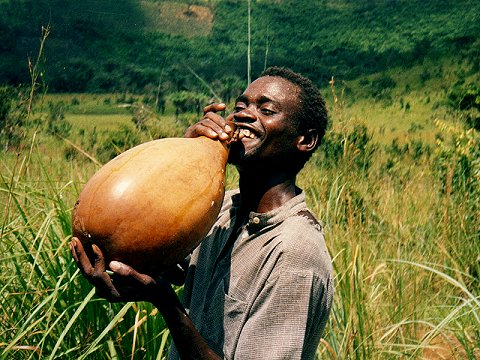 |
| Young African drinking palm wine from
gourd vessel |
Calabashes are used to collect and store palm wine in Congo. Al;so in South Africa, it is commonly used as a drinking vessel by tribes such as the Zulus.
The Luo of Kenya make a large traditional bugle from bottle gourds, blown during ceremonies and for chasing away wild animals.
Caribbean and America
The popular, painted calabash gourds of the Caribbean, Mexico and Central America come from a native tropical American tree that belongs to the Bignonia Family
(Bignoniaceae), along with catalpa and jacaranda trees. There are two species of Calabash trees that grow wild in
Mexico, Central and South America, Crescentia alata and C. cujete.
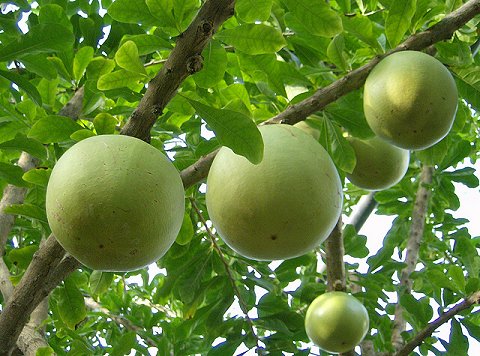 |
| Calabash Tree (Crescentia
cujete) |
The Caribbean
Calabash is primarily used for utensils, such as cups, bowls, and basins in rural
areas. It can be used for carrying water or can be made for carrying items, such as
fish, when fishing. In some Caribbean countries, it is worked, painted and decorated as shoulder bags or other items by
artisans, and sold to tourists.
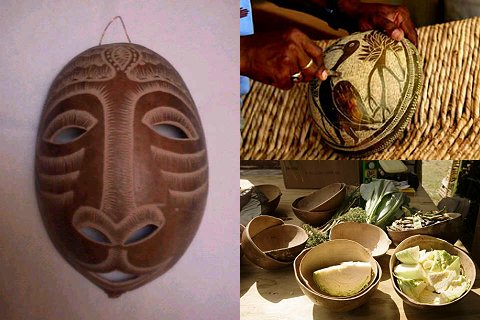 |
Wall mask from calabash tree (left)
Carving in calabash tree (right up), utensils from calabash tree (right
down) |
In Jamaica, it is also a reference to the natural lifestyle of Rastafarians. As a
cup, bowl, or even water-pipe or "bong", the calabash is considered consistent with the
"Ital" or vital lifestyle of not using refined products such as table
salt, or using modern cooking methods, such as microwaves. In Haiti, the plant is called kalbas
kouran, literally "running calabash", and is used to make the sacred rattle emblematic of the Vodou
priesthood, called an asson. As such, the plant is highly respected. It is also the national tree of
St. Lucia.
North America - Mexico
In many rural parts of Mexico, the calabash is dried and carved hollow to create a bule or a guaje, a gourd used to carry water around like a canteen. The gourd cut in half, called jícara, gave the parallel name to a clay cup jícara.
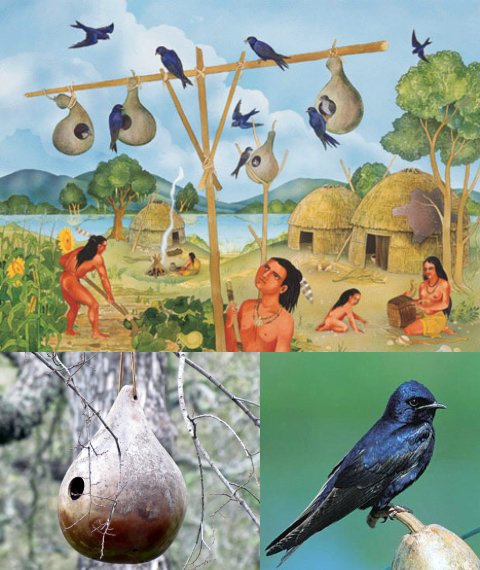 |
Native-American Indians using gourd bird houses (painting representation) (up).
Gourd bird house (down left), Purple Martin Progne subis (down right) |
The native-Americans used gourd bird houses with square holes because they wanted to attract purple Martins? 2 kinds of these birds were also reproducing in Mexico. The passion for creating and buying gourd bird houses started with indigenous people in Mexico and Native Americans who used the first gourd birdhouses; this is one of the expressions of Native American gourd art.
Gourd decoration, is an ancient tradition among the indigenous peoples of the Americas, notably the central highland people of Peru, the Navajo, Hopi and Pueblo nations of the American Southwest, and the Nuxálk and Haida nations of British
Columbia.
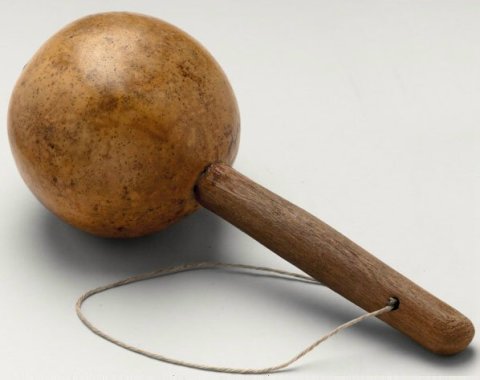 |
|
Native American rattle from Kumeyaay Indians, California |
Native American rattles, aboriginal musical instruments, are typically constructed of natural gourds, desert willow handles, palm seeds to make rattle sounds. Traditional gourd rattles used by the aboriginal Kumeyaay California Indians of North America, the Indigenous peoples of Southern California, San Diego County, northern Baja California, Mexico, are typically played during traditional Native American religious and spiritual ceremonies.
South America
In Argentina, Peru, Brazil, Uruguay and Paraguay, a small gourd is made into a special cup for drinking "yerba mate," a popular tea brewed from the leaves of a native holly (Ilex paraguariensis). Mate is sipped through a perforated metal straw called a "bombilla in Argentina." In Brazil, this container is called cuia, porongo or cabaça.
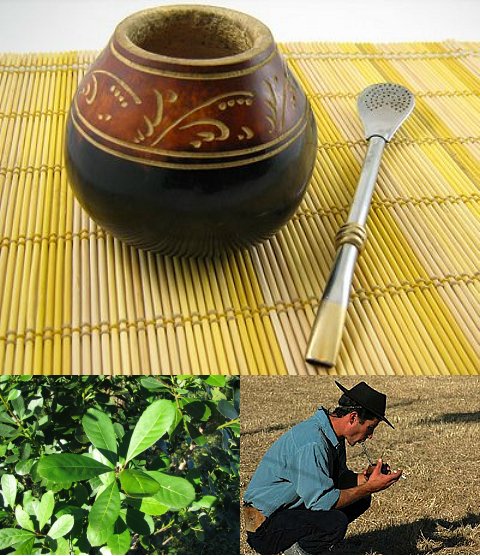 |
Yerba Mate cup and metal straw Bombilla (up)
Mate plant (Ilex paraguariensis) (down left), Argentinian Gaucho
drinkingé Yerba Mate (down right) |
Mate gourds are often fashioned with silver rims or collars and support bases. Old mate gourds improve the flavor of this caffeine-rich tea and mate connoisseurs would never think of using glass, pottery mugs or styrafoam
cups.
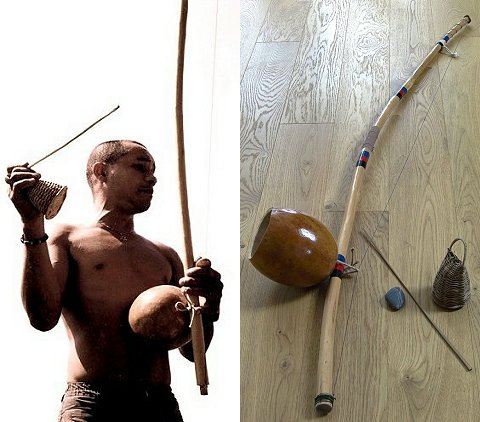 |
| Berimbau player (left, Berimbau
parts (rigth) |
Gourds also commonly used as the resonator for the berimbau, the signature instrument of capoeira, a martial art/dance developed in Brazilian plantations by African slaves.
In Peru, Bolivia and Ecuador, calabash gourds are known to have been used for medicinal purposes for over a thousand years by Andean cultures. The Inca culture applied folklore symbology to gourds to pass down from one generation to another, and this practice is still familiar and valued.
Gourd decoration, is an ancient tradition among the indigenous peoples of the
South Americas, notably the central highland people of Peru.
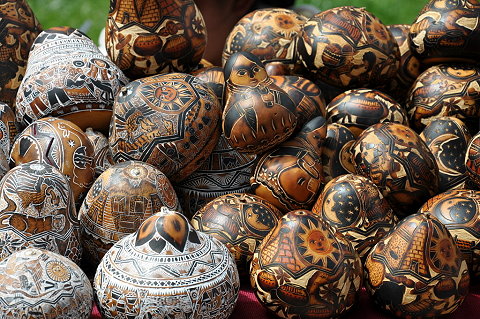 |
| Decorated calabash in Cusco, Peru |
Bowls made of calabash were used by Indigenous Brazilians as utensils made to serve food, and the practice is still retained in some remote areas of Brazil (originally by populations of various ethnicities, origins and regions, but nowadays mainly the indigenes
themselves).
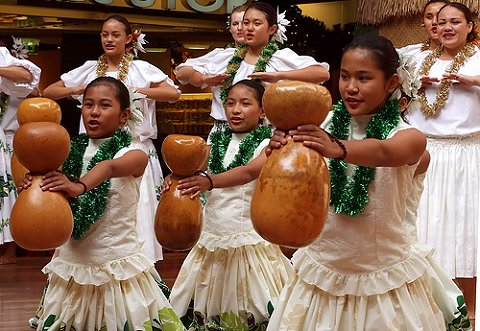 |
| Hula dancers with ipu heke |
In Hawaii, this gourd is often dried when ripe and used as a percussion instrument called an ipu heke in contemporary and ancient hula.
India
Hindu ascetics (sadhu) traditionally use a dried gourd vessel called the kamandalu. The juice of bottle gourd is considered to have medicinal properties and to be very good for health.
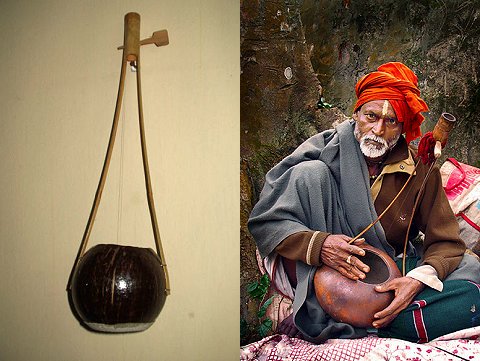 |
| Ektara (left) and Baul singer of Begali
playingé ektara
(right) |
The Baul singers of Bengal have their musical instruments made out of it.
The most common is the ektara, a one-stringed “plucked drum” drone instrument, carved from the epicarp of a gourd, and made of bamboo and goatskin. The practice is also common among Buddhist and Jain
sages.
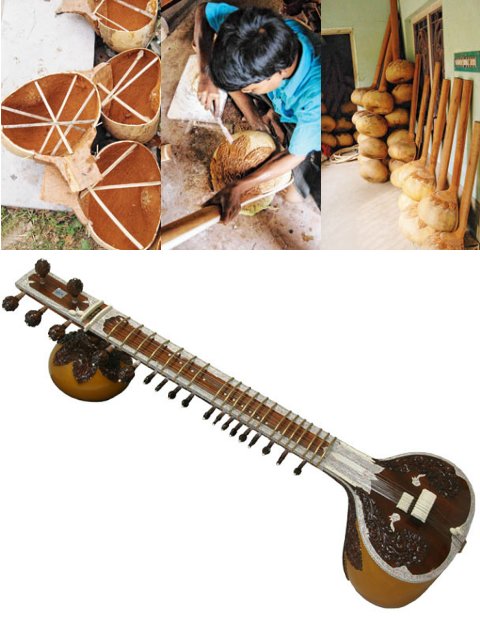 |
| Making sitar instruments (up) and sitar
with duble tumba (down) |
The sitar is a famous plucked stringed instrument used mainly in Hindustani music and Indian classical music. The gourd (kaddu) forms the bulk of the resonator (tumba) on the
sitar.
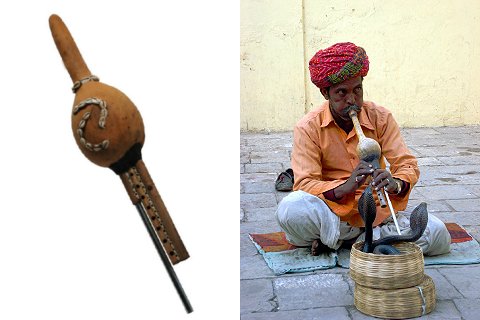 |
| Pungi (left) and Snake charmer playing
pungi (right) |
The pungi, also called the been, or bin is a wind instrument played by snake charmers in India and Pakistan. The instrument consists of a mouth-blown air reservoir made from a gourd, which channels air into two reedpipes. The pungi is played with no pauses, with the player employing circular breathing. The pungi originated in India and is still played by snake charmers in street performances.
China
The Chinese name for Calabash is hulu. The hulu is an ancient Feng
Shui symbol for health. In the old days, doctors would carry medicine inside it, so it has fabled properties for healing. The hulu is believed to absorb negative earth-based qi (energy) that would otherwise affect health, and is a traditional Chinese medicine cure. Dried calabash is also used as containers of liquids, often liquors or medicine. The Chinese consider the number "8" to be very auspicious and an omen for good luck. The hulu gourd, resembles the number "8".
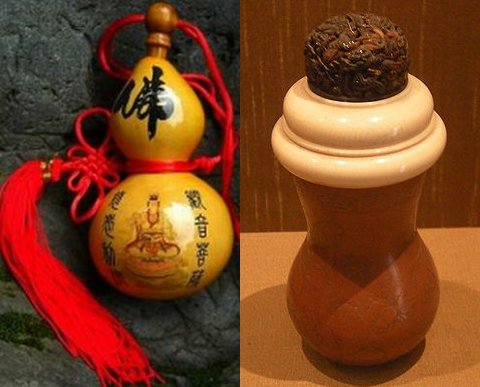 |
| Hulu charm with red ribbon (left),
A Qing dynasty cricket cage (right) |
Calabash gourds were also grown in earthen molds to form different shapes with imprinted floral or arabesque design and dried to house pet crickets, which were kept for their song and fighting abilities. The texture of the gourd lends itself nicely to the sound of the animal, much like a musical instrument. It is a symbol of the Xian
immortals.
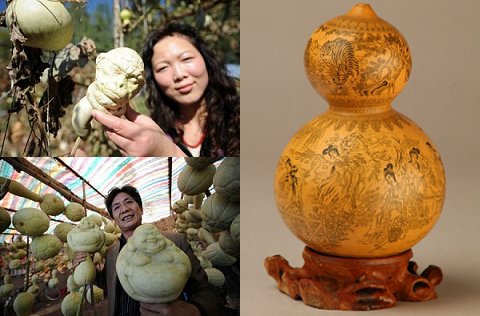 |
| Molded groud growers in Lanzhou (left),
Piece of art, carved gourd in Lanzhou (right) |
Lanzhou city is the capital of China’s Gansu province. Lanzhou gourd carving originated out of practicality. Lanzhou City, as the most important spot on the Silk Road, attracted many merchants. Merchants from the Hu tribe held water among gigantic gourds that were sculpted with Chinese temperaments and patterns
Nowdays Lanzhou gourd growers use a biotechnology technique to cultivate various shapes from the calabash, turning the gourd into an artwork. Gourds can be molded and shaped into Buddhas and gargoyle heads…among other
things.
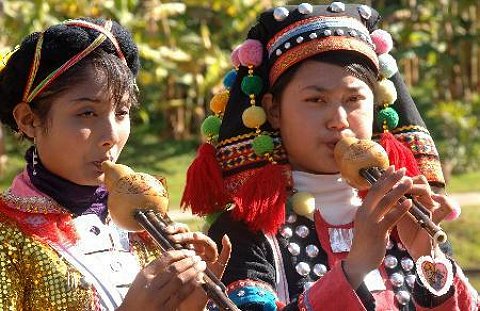 |
| Girls from Dai tribe of Southwest China
playing Hulusi |
The hulusi is a free reed wind instrument from China. It is held vertically and has three bamboo pipes which pass through a gourd wind chest; one pipe has finger holes and the other two are drone pipes. The hulusi was originated by ethnic Dai Tribe of Southwest China, which can be dated back to Qin and Han Dynasties (221 BC to 220
AD).
Indonesia
But of all the uses for gourds, some of the most interesting are the "penis sheath gourds". The koteka, horinm, penis gourd or penis sheath is a phallocrypt or phallocarp traditionally worn by native male inhabitants of some (mainly highland) ethnic groups
of Papua in New Guinea to cover their genitals. They are normally made from a dried out gourd, Lagenaria siceraria, although other species, such as Nepenthes mirabilis, are also used.
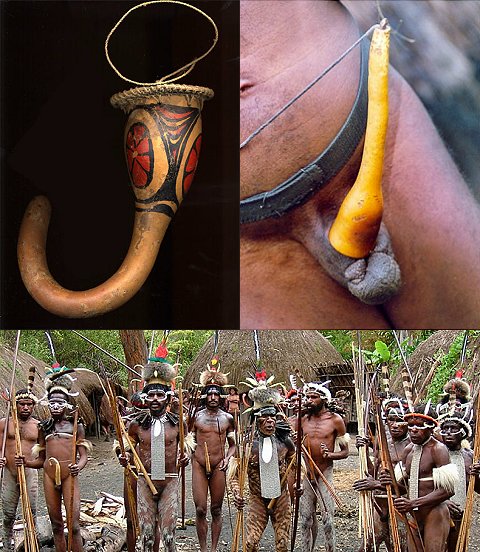 |
Decorated Penis cover koteka (up left)
Penis cover koteka worn with a belt (u[ right)
Men from Dani tribe of Papua highlands New Guinea, wearing koteka (down) |
Penis gourds are also known from Africa and northern South America. There is considerable speculation among anthropologists about the purpose of such gourds, but most agree that they are more than a protective device and serve an important social
function.
Europe - U.K.
Additionally, the gourd can be dried and used to smoke pipe tobacco. A typical design yielded by this squash is recognized (theatrically) as the pipe of Sherlock Holmes, but Doyle never mentioned Holmes using a calabash pipe. It was the preferred pipe for stage actors portraying Holmes, because they could balance this pipe better than other styles while delivering their lines.
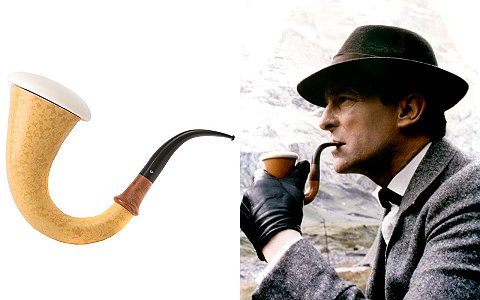 |
Calabash pipe, model "Sherlock
Holmes" (left)
British actor Jeremy Brett portraying Sherlock
Holmes smoking Calabash pipe (right) |
Today
Gourd crafting and painting has evolved from early hand carvings to the modern day use, by some, of electric wood burners and high-speed pen-shaped rotary tools that can be used to inscribe almost any design.
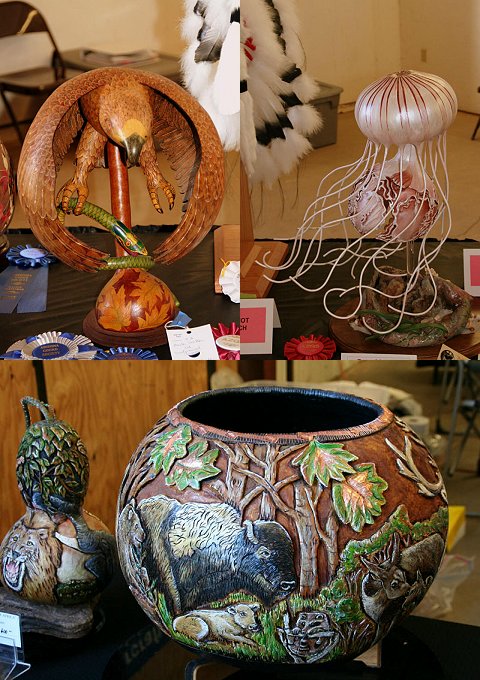 |
| Calabash art: Eagle and snakeé
(up left), Jellyfish (up right), Wild life (down) |
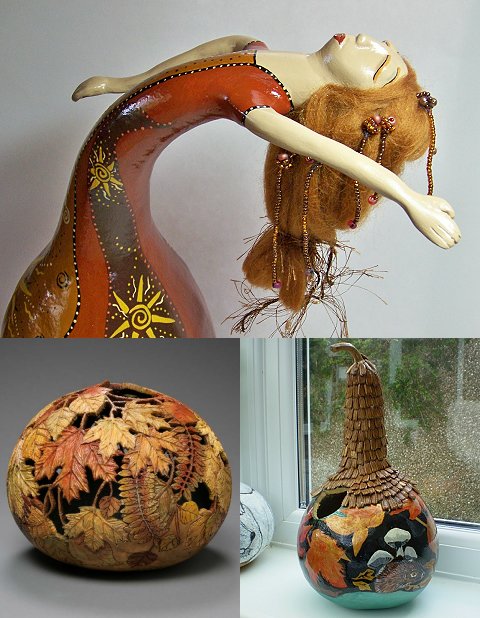 |
Calabash art:
Woman dancer (up), Pyrographic sculpture
(down left), Bird house (down right) |
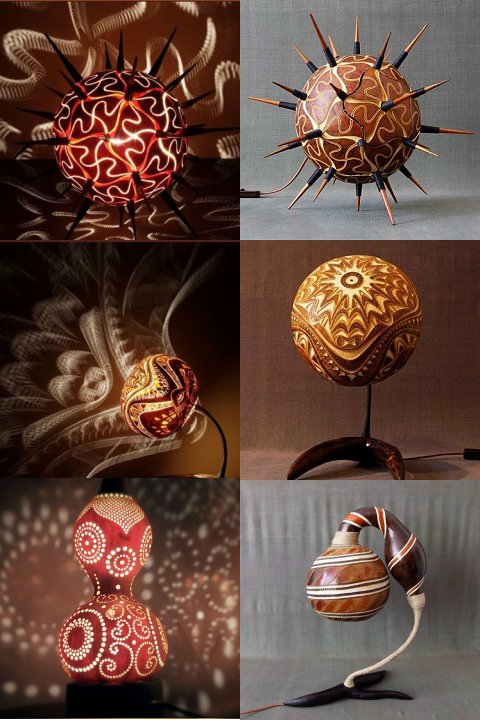 |
| Calabash art: Carved lamps |
A wide variety of gourd shapes and sizes yields an array of art pieces, including: ornaments, bowls, sculpture, vases, lamps, and wall art such as masks. Artistic styles can range from craft to fine
art.
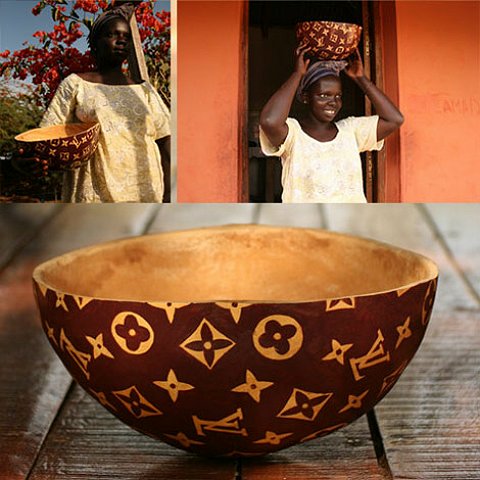 |
| Calabash art: Louis Vuitton calabash
Dakar, Senegal. |
But the calabash even when inspiring artists loses nothing of its use as
luggage. It is natural, therefore, that a famous luggage brand such as Louis Vuitton could be expressed with the oldest natural
baggage. Frenchman artist Sebastien Bouchard created an African gourd utensil by painting it with the colors and logos of Louis Vuitton for an exhibition in
Dakar, Senegal. A modern luggage 10.000 years old!
Michael
Politis
|
